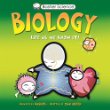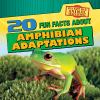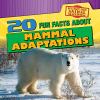-
-
2002., Ferguson Publishing Company Call No: CAREERS 574 PAT shelf 2 Availability:1 of 1 At Location(s) Series Title: CareersSummary Note: Explores twenty-one careers in the field of biology, in terms of the nature of the work, educational or training requirements, ways to get started, advancement possibilities, salary figures, employment outlook, and sources of more information.
-
-
1996, 2000., EXAMgen, Incorporated Call No: REF 373.196 EXA Availability:1 of 1 At Location(s) Series Title: Databases for scienceSummary Note: Databases of questions for Biology.
-
-
1998, 2000., EXAMgen, Incorporated Call No: REF 373.196 EXA Availability:1 of 1 At Location(s) Series Title: Databases for scienceSummary Note: Databases of questions for Biology.
-
-
-- Life as we know it!2008., Pre-adolescent, Kingfisher Call No: LIfe Science Edition: 1st American ed. Availability:1 of 1 At Location(s) Summary Note: Provides an overview of biological topics, discussing cells and the building blocks of life; describing the characteristics of living creatures, from viruses to mammals; and examining body parts and plants.
-
-
-- Spider silk is stronger than steelBy Gore, Bryson[2006], Juvenile, Stargazer Books Call No: 570 Edition: Stargazer Books lib Availability:1 of 1 At Location(s) Summary Note: Presents a short study of the science of the animal kingdom, and contains information about animal species, survival techniques, behavior patterns, and more.
-
-
By Hakim, Joy2023., Adolescent, MITeen Press Call No: 570.9 HAK Edition: First edition. Availability:1 of 1 At Location(s) Summary Note: "When did we start learning the scientific secrets of life? Step back to the Islamic Golden Age, when scholars ask questions about life science and medicine that will establish those fields. Chart a path through the Renaissance, as Leonardo da Vinci dissects cadavers by candlelight to learn human anatomy firsthand. In this first of four volumes spanning hundreds of years of scientific innovation and discovery, follow the evolution of life science up to the late 1800s, when a baffled Dutch biologist finds a tiny infectious particle destroying tobacco crops and gives this particle a new name: virus. With Biology's Beginnings: Discovering Life's Story, best-selling author Joy Hakim begins a quartet of volumes mapping the path of human discovery as we unlock the biological secrets of our own existence. Richly illustrated with archival source materials and fine art, this STEM treasure trove features a wealth of back matter certain to kindle the appetite of science lovers"--From the publisher's web site.
-
-
2014., Pre-adolescent, Scholastic, Incorporated Call No: 591.47 Availability:1 of 1 At Location(s) Summary Note: Large full-color photos of camouflaged animals allow readers to see insects, reptiles, mammals, birds, and fish blend into their backgrounds and learn how and why these amazing animals have developed these adaptations.
-
-
-- One hundred one hidden animals[2014], Juvenile, Scholastic Inc. Call No: 591.47 Availability:1 of 1 At Location(s)Click here to watch Summary Note: Examines the camouflage techniques of 101 animals. Features full-color photographs of the animals hidden in their native habitats.
-
-
[2016]., Gareth Stevens Call No: 597.8 MAH Availability:1 of 1 At Location(s) Summary Note: Reptiles lay their eggs on land and most spend a lot of their time out of the water. While this is a fact today, it wasn t always this way. Living on land is an adaptation reptiles underwent millions of years ago. Even more adaptations, such as how reptiles regulate their body temperature and their scaly skin, are more apparent to those studying crocodiles, turtles, and other reptiles in modern times. Using a unique format of short facts, this book introduces readers to the science concepts of evolution as well as the features that classify an animal as a reptile. Detailed Table of Contents, Full-Color Photographs, For Further Information Section, Glossary, Graphic Organizers, Index.
-
-
-- Twenty fun facts about mammal adaptationsJuvenile Call No: 599 RAJCZAK Availability:1 of 1 At Location(s) Summary Note: One major adaptation of mammals is part of what differentiates them from other animals: the growth and nourishment of babies inside the mother's body. Water-repelling fur, tough hides, camouflage, as well as the size and shape of various body parts are just a few other adaptations mammals have developed in order to better survive their environment. Readers learn many examples of how mammals have evolved to hide from predators and hunt for prey. Graphic organizers present even more information to aid readers' understanding while full-color photographs bring them close to animals they might otherwise only see in a zoo.
-
-
-- Twenty fun facts about marine animal adaptationsBy Cole, TaylerJuvenile Call No: 591.77 COLE Availability:1 of 1 At Location(s) Summary Note: Marine animals have adapted to their habitat over millions of years. Huge whales and giant squids have been able to grow exceptionally large despite the absence of strong limbs due to the buoyancy of living in salt water. Blubber keeps some animals warm in the deep as other adaptations let animals live in very warm waters. Readers dive into the complex and fascinating subject of life under the sea through 20 interesting facts about how bodies, predation, camouflage, and more have evolved below the surface.
-
-
-- Twenty-four hours in an estuaryc2018., Pre-adolescent, Cavendish Square Call No: 577.7 86 Edition: 1st ed. Availability:1 of 1 At Location(s) Summary Note: Spend a day in an estuary and see why its environment is one of the most important on earth.
-
-
-- Ocean.By McKay, Sindyc2001., Juvenile, Treasure Bay Call No: 577.7 Edition: 1st ed. Availability:3 of 3 At Location(s) Series Title: We Both Read Volume: Level 1-2Summary Note: This book explores many aspects of the ocean environment that will excite readers, both young and old. Journey from coral reefs to deep seas to sandy shores. Learn interesting facts about life in the ocean including dolphins, sharks, whales, starfish and much more.
-
-
c2009, Greenhaven Press Call No: 304.2 5 Availability:1 of 1 At Location(s) Series Title: At IssueSummary Note: A collection of thirteen essays that explore various issues related to climate change, discussing its impact on communities and the environment.
-
-
-- Adaptation & survivalc2012., Pre-adolescent, Raintree Call No: 578.4 SNE Availability:1 of 1 At Location(s) Series Title: Web of lifeSummary Note: Explores how organisms adapt to changing environments, from changes in physical appearance to adaptations in behavior, and examines the evolution of different plant and animal species.
-
-
c2009, M.E. Sharpe Call No: 578.4 Availability:1 of 1 At Location(s)Table of contents only Series Title: Genetics, the science of life
-
-
2003., Pre-adolescent, Grolier Educational Call No: 578.4 Availability:1 of 1 At Location(s) Series Title: Science matters!Summary Note: Presents information on habitats and the methods used by various plants and animals to protect themselves.
-
-
-- Adapting to plant & animal extinctions2013., Pre-adolescent, Rosen Central Call No: 591.3 FUR Edition: 1st ed. Availability:1 of 1 At Location(s) Series Title: Science to the rescueSummary Note: Describes how people are adapting to the increase in plant and animal extinctions caused by global warming.
-
-
-- Africanized honeybee versus army ant[2019]., Gareth Stevens Publishing Call No: 595.79 9 Availability:1 of 1 At Location(s) Summary Note: Africanized honeybees, also known as killer bees, and army ants are both tiny animals that really strike fear in many people. In this action-packed volume, readers will follow along with a battle of the insects and decide who they think would be the ultimate victor. Readers will learn about factors such as adaptations, size, and sting. They'll use the information to make an educated guess about which insect they think would win if such a battle were to really break out. This imaginative, high-interest book is loaded with eye-catching graphics and facts that support important elementary science concepts.
-
-
c2011., Juvenile, Charlesbridge Call No: 591.5 3 Availability:1 of 1 At Location(s) Summary Note: Once the lions have killed their prey and eaten their fill, what happens to the leftovers?.




















